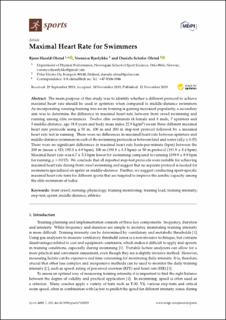| dc.contributor.author | Olstad, Bjørn Harald | |
| dc.contributor.author | Bjørlykke, Veronica O. | |
| dc.contributor.author | Olstad, Daniela Schäfer | |
| dc.date.accessioned | 2020-05-13T10:36:54Z | |
| dc.date.available | 2020-05-13T10:36:54Z | |
| dc.date.created | 2020-01-10T11:01:56Z | |
| dc.date.issued | 2019 | |
| dc.identifier.citation | Sports. 2019, 7 (11), 235. | en_US |
| dc.identifier.issn | 2075-4663 | |
| dc.identifier.uri | https://hdl.handle.net/11250/2654223 | |
| dc.description | This is an open access article distributed under the Creative Commons Attribution License (https://creativecommons.org/licenses/by/4.0/) which permits unrestricted use, distribution, and reproduction in any medium, provided the original work is properly cited. | en_US |
| dc.description.abstract | The main purpose of this study was to identify whether a different protocol to achieve maximal heart rate should be used in sprinters when compared to middle-distance swimmers. As incorporating running training into swim training is gaining increased popularity, a secondary aim was to determine the difference in maximal heart rate between front crawl swimming and running among elite swimmers. Twelve elite swimmers (4 female and 8 male, 7 sprinters and 5 middle-distance, age 18.8 years and body mass index 22.9 kg/m2) swam three different maximal heart rate protocols using a 50 m, 100 m and 200 m step-test protocol followed by a maximal heart rate test in running. There were no differences in maximal heart rate between sprinters and middle-distance swimmers in each of the swimming protocols or between land and water (all p ≥ 0.05). There were no significant differences in maximal heart rate beats-per-minute (bpm) between the 200 m (mean ± SD; 192.0 ± 6.9 bpm), 100 m (190.8 ± 8.3 bpm) or 50 m protocol (191.9 ± 8.4 bpm). Maximal heart rate was 6.7 ± 5.3 bpm lower for swimming compared to running (199.9 ± 8.9 bpm for running; p = 0.015). We conclude that all reported step-test protocols were suitable for achieving maximal heart rate during front crawl swimming and suggest that no separate protocol is needed for swimmers specialized on sprint or middle-distance. Further, we suggest conducting sport-specific maximal heart rate tests for different sports that are targeted to improve the aerobic capacity among the elite swimmers of today. | en_US |
| dc.language.iso | eng | en_US |
| dc.subject | front crawl | en_US |
| dc.subject | running | en_US |
| dc.subject | physiology | en_US |
| dc.subject | training monitoring | en_US |
| dc.subject | training load | en_US |
| dc.subject | training intensity | en_US |
| dc.subject | step-test | en_US |
| dc.subject | sprint | en_US |
| dc.subject | middle distance | en_US |
| dc.subject | athletes | en_US |
| dc.title | Maximal Heart Rate for Swimmers | en_US |
| dc.type | Peer reviewed | en_US |
| dc.type | Journal article | en_US |
| dc.description.version | publishedVersion | en_US |
| dc.rights.holder | © 2019 by the authors. | en_US |
| dc.source.pagenumber | 12 | en_US |
| dc.source.volume | 7 | en_US |
| dc.source.journal | Sports | en_US |
| dc.source.issue | 11 | en_US |
| dc.identifier.doi | 10.3390/sports7110235 | |
| dc.identifier.cristin | 1770072 | |
| dc.description.localcode | Seksjon for fysisk prestasjonsevne / Department of Physical Performance | en_US |
| cristin.ispublished | true | |
| cristin.fulltext | original | |
| cristin.qualitycode | 1 | |
